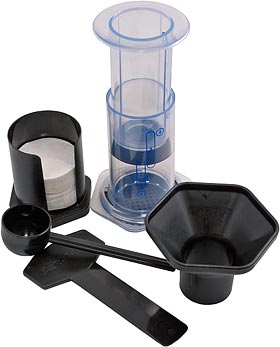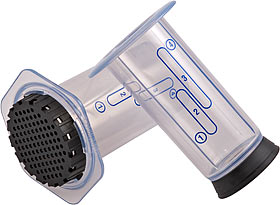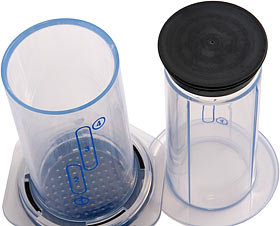
Review: Aerobie AeroPress
Review date: 28 April 2006 Last modified 09-Oct-2012.
There are several hurdles that kitchen gadgets have to clear in order to be a success.
First, they have to actually, um, work. A coffee maker, for instance, has to make coffee. Not necessarily great coffee, but it must successfully pass hot water over coffee grounds.
You may now, if you wish, say "duh". But the late-night I Can't Believe They Invented It devices often don't manage to pass this test.
Kitchen gadgets also have to be easy, and fast, enough to use that you actually will use them. Again, numerous Miracle Gadgets fail here, but so do lots of perfectly good things like espresso machines and juice extractors. People find that even if they've got the exact same machine at home as is used in the cafes, they're still willing to pay extra to have someone else operate the darn thing for them.
Kitchen (and other) gadgets also have to be easy enough to clean that you'll use them more than once. Again, coffee machines and juicers spring to mind as offenders in this regard, but so do umpteen chopping and peeling and frying sorts of things. Ideally, a gadget shouldn't even need cleaning for quite a long time (multiplied by at least five, for bachelors), but every gadget can't be a toaster.
They also have to be well enough designed and built that they don't fall apart.
And, on top of all that, they have to be cheap enough that people don't just see them mentioned on some gadget blog and express interest until the number at the end causes them to faint dead away.
Oh, and they shouldn't come with specialised implements which are easy to lose or break, and without which the device cannot be operated.
And so, to the Aerobie AeroPress. Aerobie are chiefly known for their range of flying toys, headed off by the eponymous flying ring whose chief problem, upon its introduction more than 20 years ago, was that unlike normal flying discs, the darn thing tended to fly too far to be a practical toy.
(Now there's a smaller version with less range, along with various other items more or less based on the original.)
Presumably, the Aerobie people observed that most of the people who bought Aerobies in 1985 now need at least one cup of coffee before they can remember how to find their way out of the house, and so they made the AeroPress.
The AeroPress does not fly. It makes coffee. According to the manufacturers, it makes very good coffee. But, of course, every coffee gadget is supposed to bring you the true essence of the most exclusive civet bowels, or whatever. Sometimes these claims are more or less justified, often they are not.
So I was interested to see whether the AeroPress passes the various Kitchen Gadget Tests.
I, myself, have considerable affection for caffeine,
but am as unschooled in the ways of coffee as I am in oenology.
Fortunately, I have access to several coffee snobs experts upon whom the AeroPress's output was tested
over a period of weeks.
The AeroPress certainly is a novelty. Aerobie have managed to come up with a genuinely new way of brewing coffee. It's closely related to the way an espresso machine works, but it's not the same. This development, in itself, is something of an achievement - people may have been making coffee in devices more complex than an open pot for five hundred years, so you'd think all of the options would have been pretty much played out by now.
(For the benefit of the people who keep e-mailing me to say that the AeroPress looks like a French press to them: Yes, I know what a French press is. They're so common here in Australia - where we just call them "plungers" - that when I first wrote this review I neglected to even mention them, assuming that everyone had one sitting in their cupboard already, even if they didn't use it. The AeroPress looks like a French press, but it works more like an espresso machine. The French press is cheaper than an AeroPress and doesn't use paper filters, but in every other respect the AeroPress is superior.)
Here's the deal, for those of you too lazy to download the instructions (PDF here).
You take one of the small, round paper filters the AeroPress comes with, twist the coarsely perforated cap off the plunger cylinder, put the filter in and replace the cap.
That's the cap on the left there.
Now you put your coffee in the plunger cylinder; one scoop (with the provided scoop) for one ISO Standard Coffee, or as many as four scoops if you want more. The AeroPress comes with a funnel that fits neatly into the cylinder, so you can easily sit it under a coffee grinder, if you stomp the beans yourself. Less dedicated users can just use the scoop.
Now you sit the plunger cylinder on top of a mug, and pour in your water, using the top portion of the plunger assembly to measure it out. Markings on the side of the assembly make the measuring easy. You're also instructed to use water that's hot, but not too hot. It turns out that coffee brews better with water in the 75 to 80°C range than with the tea-temperature near-boiling water with which coffee is often made - or the briskly boiling water, mixed with who-knows-how-hot steam, with which various gadgets make it.
You only need to mix the coffee and water for ten seconds. Then you insert the rubber end of the plunger in the cylinder, as if assembling a syringe, and press down firmly. After about twenty seconds of pressing, the water will all have been pushed through the filter. Leave to drip for a couple of seconds, remove AeroPress from top of mug, pour in any diluting water/milk/whatever, and you're done.
You get a measuring scale on the cylinder as well as on the plunger part, but pouring the water straight into the cylinder makes it harder to measure properly.
The AeroPress makes espresso-strength (or stronger - a doppio ristretto can easily be yours) coffee. As in a cafe, you're expected to dilute the result yourself if you don't want a spoon-dissolver of a drink. The quick-brewed, limited-heat espresso, though, is less bitter and sour than coffee made with more water, more time and more heat.
If you want coffee with fancy foam on it, the AeroPress can't help you - it doesn't make a traditional espresso "crema" either.
This, fortunately, doesn't seem to matter. A normal espresso pull that doesn't have crema has been done wrong, but the AeroPress plays by different rules. And as far as other coffee-toppers go, those little cheap battery powered whizzer things will foam your milk or whatever just fine. Based on the experiences of the several coffee enthusiasts that've trialled the AeroPress here, pretty much everything else in the basic coffee menu is just decorative.
No, AeroPress espresso doesn't look like steam-and-pressure cafe espresso, but it tastes, if anything, better. Short brewing time with dilution after brewing gives more of the stuff that makes coffee good and less of the later brew products that make it bitter and acidic.
Tea brews similarly, by the way. If all you want is the caffeine and minimal taste then you can brew tea for only about 30 seconds (and then you can reuse the leaves to make fairly normal tasting but decaffeinated tea, if you're a wimp), but somewhere around three minutes of brewing time is optimal for most black tea. Leave it longer and you get more of the nasty and less of the nice.
There's no accounting for taste, of course; coffee freaks fight religious wars over whether franchise-store brews are just "dark" or actually "burned", and in various parts of the non-English-speaking world all bets are off. But if you like coffee from quality non-chain cafes, you'll probably like AeroPress coffee just as much, if not more.
Cleaning the AeroPress is easy, too. You just remove the cap over the filter, then push the plunger a bit further, and the grounds pop off as one neat puck, straight into the bin if you like. The rest of the AeroPress only needs a quick rinse.
You can bin the filter each time too, if you like, or recover it and give it a wash for reuse; each filter will last for several cups. If the filter hasn't had any holes poked in it, it keeps all of the grounds out of the cup. There will be zero sludge in the bottom of your mug.
Some people simply won't stop telling me that the AeroPress is just another kind of French press, so here's why it isn't, in detail. Everybody else can just take it as read and skip this bit.
The AeroPress, like an espresso machine, pushes a small amount of water through the grounds, which means you get the more readily water soluble/mixable components of the coffee, but not much of the the ones that seep into the water slower, over a longer brewing period. Since those longer-brew components don't happen to taste as nice (to most people, at least), this is a good thing.
A French press, in contrast, leaves the grounds swirling around in a larger amount of water for a much longer period. Then the wire screen - which is like chicken wire, compared with a paper filter - on the end of the plunger pushes most of the grounds down into the bottom of the cylinder (fine and not-so-fine particles get through the wire), and the grounds are somewhat isolated from further steeping. But they are still immersed in the water, down in the bottom of the cylinder, and a non-trivial amount of brewing still occurs.
So, I hear you say, what if you used a French press with less water, steeped the grounds in that water for less time, then pushed down the plunger and immediately poured off the pseudo-espresso you'd just made?
Well, that'll get you closer to AeroPress-type coffee, but there'll still be the same amount of fine particles coming through the wire screen, and around its edge. Those fine particles make up the "sludge" in the bottom of every cup of plunger coffee, and if you use less water you get more sludge, as a proportion of the total coffee. Those particles also, by definition, have a lot of surface area per unit volume; they're therefore the ones that brew with the most enthusiasm, and they contribute more of the late-brew products that you don't want to drink. You may well like your coffee vivid and gritty, but that sure ain't espresso.
If you intend to dilute the coffee then the proportional difference disappears, but you've still got the sludge-taste problem.
OK, wise guy, I hear you say now; what if you give the plunger a disposable paper filter like the AeroPress?
Well, now you've got the problem that the paper filter is much less permeable than the wire one. The paper filter also can't seal to the edge of the cylinder - it'll just shred if you make it that big - so the edge seal has to stay as wire (which will now let more sludge through than used to get through the edge, thanks to the higher pressure created by the less permeable main filter), or be rubber or some fancy high-lubricity plastic or other.
The problem you now face is that your cylinder seal will rapidly deteriorate, because it can't avoid being scratched by the floating grounds. (There may be some other problems cause by pushing on incompressible water rather than water with a compressible layer of air above it, too - or there may not.)
The AeroPress's rubber plunger seal hardly gets wet at all as you push it down. It pushes on the air at the top of the cylinder, and the air pushes the brew through the filter. By the time the seal makes it down to, um, grounds level, air has been hissing through the damp grounds for a while and the brew's all in the cup underneath.
The AeroPress plunger does squeegee grounds down the side of the cylinder as it goes, but they're not floating around in pressurised liquid that's trying to find any way out. They're just stuck peacefully to the cylinder sides, surrounded by mildly pressurised air that isn't trying to move them anywhere.
Incidentally, there's a mini-review of the AeroPress, with a video clip of it in use, here.
So, to recap the Kitchen Gadget Tests:
The AeroPress does make coffee, and makes it well.
It's easy to use.
That's particularly good for a coffee-maker, because coffee-makers are often operated by a person who hasn't had any coffee yet. In that situation, no amount of simplicity is too much. At this juncture, I humbly venture the opinion that the best source of "COFFEE NOW DAMMIT" merchandise is here.
About the only way you're likely to go wrong with an AeroPress is if you forget the bit in the instructions that says that fine espresso-grind coffee is OK for an AeroPress, but only if you're using just one scoop of it. For two scoops or more, you should use coarser drip-grind coffee, or the filter will clog up hard. This can produce amusing results when you push the plunger down, discover that it won't move, and then start thinking about how best to remove the plunger again without splashing half-brewed coffee around.
Apart from that, though: Definitely easy to use, even if you're still half-asleep.
The AeroPress is fast to use, too. Faster than pretty much any other way of making a small batch of coffee, actually, except for using instant. Many people will, of course, contend that instant doesn't count, on account of not actually leaving you with anything that resembles coffee.
The AeroPress is also easy to clean.
And the AeroPress won't fall apart. It's made out of boring plastic, but that means you can't break it by dropping it. The rubber seal on the plunger should last, too, provided you follow the instructions and don't leave the plunger stuck in the cylinder.
(I'm giving this review a little polish now, almost three years after it first went up. Our AeroPress has been used daily, and every part of it is still A-OK.)
And the AeroPress is cheap, too. Here in Australia, CoffeePress.com.au (who provided my review AeroPress) sell it for $AU54 delivered, which is not a whole lot of money by the standards of the average coffee geek.
It's something of a markup on the US list price, though, which is only $US30 ex delivery - various retailers are selling it for a few bucks less, which they may or may not be making back on the shipping.
(Here it is on Amazon for $US25.95 plus delivery, for instance. Aeropresses and filter packs for them are also easy to find on eBay. With a bit of sniping you may get one for ten bucks delivered.)
A US buyer who shops around can, therefore, pay around $US30 delivered for an AeroPress, which is around $AU40 as I write this. But shipping to Australia for one AeroPress (light, but not tiny) will cost you more than $AU15, leading to a final price higher than what CoffeePress.com.au are charging. So there's no rip-off here.
The AeroPress does come with special extra bits that you could lose, but they could all be replaced easily enough. The jobs of the scoop and stirrer could be done by a recently-invented device which I believe is called something like "a spoom", and the plastic funnel could be replaced with, oh, perhaps a plastic funnel.
Oh, and the AeroPress is also small and tough enough that you could easily take it and your butane-powered hair dryer camping, or to a hotel, or indeed to your less-than-optimally-coffee-served office.
Oddities
While I was fiddling with the AeroPress, it occurred to me that it has a sort of medical-y, lab equipment-y look about it.
I shall gloss over the issue of what else it looked like, but it unquestionably could be used for rapid filtering of various other substances. Anything that takes ages to drip through filter paper with the help of gravity can be shoved through that paper much faster with the AeroPress, and if you use the right paper, the results should be very nearly as good.
This probably means AeroPresses will in the near future be banned in 103 countries as "drug paraphernalia". So I'd buy while the buying's good, if I were you.
Overall
If you're living a caffeine-free life, or if you choose to get your caffeine from tea, cola, yerba mate, chocolate-coated coffee beans, caffeinated peppermints in nifty tins or some other non-coffee source, then the AeroPress is not for you.
(Incidentally, I've had a more refined version of this Penguin tin amp on my to-review pile for ages, now. It's slick. It works. I'll plug it here as a partial apology for still not having reviewed it.)
Unlike most kitchen gadgets, though, the AeroPress really does clear all of the relevant hurdles. It genuinely is something that every (coffee-loving) home should have.
Coffee, like every other kitchen fixture, is surrounded by a buzzing cloud of useless crap.
I mean - coffee bags? They make more sense than instant tea, but that's about all that can be said for them.
The regrettably nonexistent Buzzaire, and the regrettably existent (well, kinda) Audi espresso machine.
The AeroPress is not like that. It will not fill everybody's coffee needs, but it's just what many people have been looking for.
Highly recommended.
Review AeroPress kindly provided by CoffeePress.com.au.
Outside Australia, it's available from
numerous other dealers.
(If you're a penny-pincher, there are lots of Aeropress auctions on eBay.)




